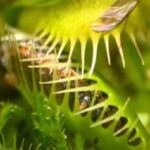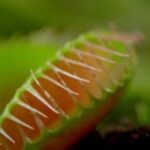As an Amazon Associate, this site earns commissions from qualifying purchases. For more details, click here.
Because Venus flytraps catch and eat small insects, people wonder if they should be classified as plants or animals. After all, that is what animals do, capture their prey and eat them. To find out if a Venus flytrap is a plant or animal, let us compare the two.
Venus flytraps are classified as plants because they can produce their own food through photosynthesis, while animals cannot. Venus flytraps also do not have a skeleton or nervous system, which animals have.
In the following examples we will break down the different aspects of Venus flytraps and animals, their similarities and differences. A lot of what follows are applicable to other plants aside from Venus flytraps.
Diet and Nutrition
The most distinguishing plant characteristic of a Venus flytrap is the ability to generate its own food through photosynthesis.
Contrary to popular belief, Venus flytraps can survive without bugs and insects. In the wild, the plant can live through sunlight, photosynthesis and whatever nutrient is in the soil or air.
Home grown Venus flytraps can also survive without insects if fed properly. You can feed Venus flytraps with Ultra Fresh Betta Fish Food and they will no longer need additional nutrients from bugs. Their traps will still try to catch bugs, but if you feed them, the plants will be fine even if they do not catch any.
Animals cannot synthesize food, they have to hunt for it. Herbivores consume plants as food. This alone is a solid indicator that Venus flytraps are plants and not animals.
Venus flytraps and other plants possess chloroplasts which is used for photosynthesis. Animals do not have this capability.
The only organisms that can photosynthesize – produce their own food – are plants, cyanobacteria and algae. And since Venus flytraps are clearly not bacteria nor algae, they are plants.
Venus flytraps are autotrophs, meaning all their carbon needs are obtainable from the water and atmosphere. Animals are heterotrophs and have to get their carbon requirements from other animals and plants.
Range of Mobility
All animals are capable of movement. It is essential to gather information about their environment and hunt for food. Venus flytraps are literally rooted to their spot. If you plant a Venus flytrap in a container like the HC Companies Planter Pot, it will stay there until it dies. You can repot the plant but it cannot move on its own.
Yes the traps of a Venus flytrap have a good range of movement. Once the trap senses a prey it closes rapidly to capture and digest it.
But the plant itself is immobile. The leaves of the plant can detect sunlight and try to get as much of it as possible. Some vines can climb walls, but this is due to their growth and not any actual movement.
Animals are capable of moving freely to hunt and go wherever it wants to go. This is a characteristic found in all of them. The fact that a Venus flytrap does not have this animal trait demonstrates it is not one.
While Venus flytraps are not mobile, they are very effective in catching prey due to the way they can respond to stimuli. When a Venus flytrap senses a prey is nearby, its trap immediately springs to action. The hair cells in the trap will shut when something makes contact with it twice.
The reason the trap only closes after two contacts is to avoid false alarms like dirt, water droplets and other objects dropping on its leaves. So even if the Venus flytrap is immobile, it can capture a lot of prey.
Physical Characteristics
All animals have a skeletal structure of some kind. A Venus flytrap does not, which is another characteristic of plants.
Every animal has some type of rigid shell – skeleton or exoskeleton – that supports its body. While there are different types of skeletal structures, they all have the same purpose, serve as a stable shell for the animal. Plants like the Venus flytrap does not have one.
Their cellular structure is also different. Venus flytraps have cell walls that help shape their form, but animals do not. You can think of the cell wall function as somewhat akin to skeletons, but their makeup and structure are very different.
Venus flytrap cells also have at least one vacuole, which provides shape to the plant and also stores water for later use. Some animals have a vacuole but it is smaller and not used as much in their body.
Do Venus Flytraps Have a Nervous System?
Animals possess a nervous system but the Venus flytrap does not. Plants however, do have sensors that can communicate with other leaves.
Plants do not have pain receptors so they do not feel pain the way animals do. Plants become aware when a leaf is cut and can transmit this message to the other leaves, but they do not feel any emotion like animals.
The ability of plants to communicate suggests that they might have some sort of equivalent to the nervous system found in animals. But more research is needed to determine this.
Bottom line: Venus flytraps can and do respond to stimulants such as light and touch. But it is not as sensitive compared to animals.
Reproduction and Growth
Another way to distinguish Venus flytraps from animals is through reproduction and growth.
Venus flytraps need insects not just for food but also pollination. A mature Venus flytrap produces a stalk with sweet smelling white flowers.
Venus flytraps can reproduce sexually and asexually. Its flowers are are part of its sexual reproduction process, and it uses insects to do so.
These flowers also have seeds and pollen. The scent attracts insects and they move the pollen to the pistil (the female section of the plant).
The flower gets fertilized, and over time whither and dies. The seeds fall into the ground and are ready to grow.
Venus flytraps can also reproduce asexually. Its roots produce a bulb root from which another Venus flytrap emerges.
In contrast, less than 0.1% of animals produce asexually. An example of this is the desert grassland whiptail lizard as well as other species. All animals also go through some blastula stage but plants do not.
Venus Flytrap and Animal Growth Compared
Venus flytraps can live for up to 20 years or so, and they will keep growing through this time. All plants grow as long as they are alive. Animals stop growing at some point.
Venus flytraps usually reach 4 to 5 inches and their traps are 1 to 1.5 inches. There are exceptions to the rule and some Venus flytraps grow bigger like the B-52 variant. The point is that all plants exhibit continuous growth which we do not see in animals.
Just to be clear, Venus flytraps are alive. They do not have the same senses as animals but they are still classified as among the living.
Summary of Why Venus Flytraps are Plants and Not Animals
There are a lot of reasons we can state why Venus flytraps are classified as plants and not animals. But the most important are the following.
- Venus flytraps have the ability to create their own food through photosynthesis. Animals cannot.
- Animals have an advanced, well developed nervous system. Venus flytraps, like other plants, can respond to stimuli but it is rudimentary compared to animals.
- Venus flytraps cannot move from one location to another. Their traps can move to catch prey and the leaves will move to receive as much sunlight as possible. But physically going from one place to another is impossible. Animals can do that.
- Venus flytraps do not possess a digestive system. While animals digest food as glycogen, plants consume them as starch.
- Venus flytraps absorb carbon dioxide and release oxygen into the air, a process that takes place n its system. Animals take in oxygen and release carbon dioxide in the air through lungs, skin, gills and other means.
- The cellular structure of Venus flytraps and animals are very different. Plants have cell walls, plastids, chloroplast and other features not found in animal cells.
- Venus flytraps grow continuously. Animals stop growing when maturity is reached.
Bottom line is that Venus flytraps are plants, not animals. Being carnivorous does not classify them as animals as there are many other carnivorous plants such as sundews or butterworts.

My fascination with carnivorous plants began many, many years ago with Venus Fly Traps. Now I am more than happy to impart what I know with other enthusiasts and those who are curious about meat eating plants.



